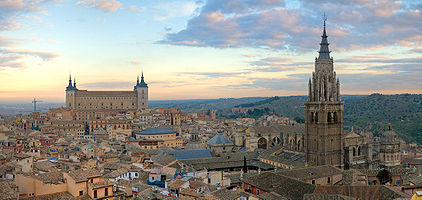Synagogues, mosques and churches jostle in the narrow streets of Toledo, which is characterised by the mixture of artistic styles.
The Mosque of Cristo de la Luz, which predates the Christian reconquest, was built in 999 as a copy of the Mosque at Córdoba. It is an unusual building with a square floor plan covered by nine caliphal vaults (a type of groined vault leaving the centre free). To this, a Romanesque-Mudejar sanctuary was added in the 12th century.
Good examples from the Mozarabs (Christians who lived under Moslem rule) are the churches of San Sebastián and Santa Eulalia, while the Mudejars left in Toledo a style with rich Arab decoration. Horseshoe arches, lobed windows and other architectural elements can be appreciated in various buildings in Toledo. Santiago del Arrabal is one of the best examples of this style in the city, which has led this church also being known as the Mudejar Cathedral. The origin of its construction is uncertain, although it was probably in the time of King Alfonso VI when the church was built, taking advantage of an old mosque. The outstanding features of the early structure are a tower which recalls a Muslim minaret.
The same Mudejar style can be seen in the church of Santo Tomé, famous for housing El Greco's famous picture entitled “El entierro del Conde Orgaz” (The burial of Count Orgaz). A 14th-century Mudejar tower stands above the rest of the building, which dates from the 12th century and has Visigothic elements on its main façade.
If there is one person's name that defines Toledo it is that of El Greco (16th-17th C.). His House-Museum, a palace with the atmosphere of the period, exhibits some of the best works of the painter who made the city world famous.

